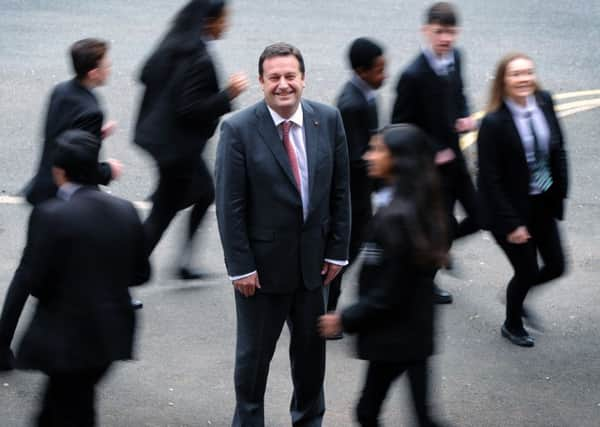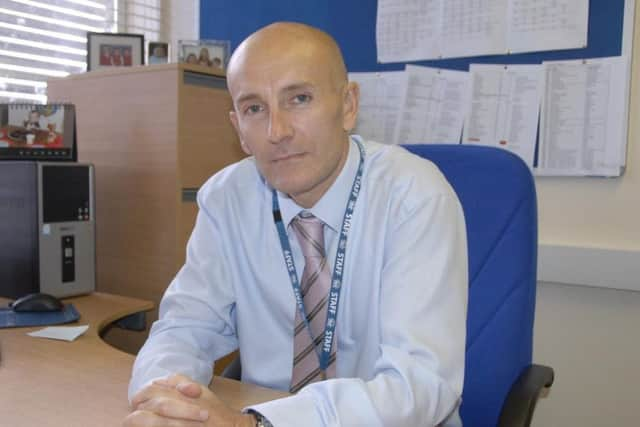Rise of Yorkshire's super-size schools


Blu-Tacked to the wall of Neil Clephan’s office is an artist’s impression showing the latest addition to the sprawling campus of Roundhay School in Leeds.
It will be the third major bout of building work in his two decades as headteacher. This latest round is designed to ensure the school can cope with its ever increasing student numbers. When he first came there were around 900 pupils. Today there are in the region of 1,700.
Advertisement
Hide AdAdvertisement
Hide AdYet even this is not enough. Roundhay’s annual intake will increase from 250 to 300 students – mostly to accommodate the children moving up from the nearby primary campus which opened in 2013 to make it a “through school” for four to 18-year-olds. It’s a picture reflected across Yorkshire as rising birth rates translate into a shortage of school places.


Last year 2.7m secondary school places were required, but figures predict this will spiral to just under 3.3m by 2024. In the here and now, the Government’s decision to stop councils building new secondary schools because of its academy and free school programme means many have no choice but to add extra forms of entry to existing institutions.
Some say these larger schools are better because they can offer a broader range of subjects. But others fear children graduating from primary school will feel swamped by the switch to a 2,000-plus pupil institution – which Roundhay will become by 2022.
Neil Clephan accepts that there are pros and cons. “I worked in a school where there were 1,400 students and I can honestly say that I could tell you all of their names and a bit about their family,” he tells me, shedding the high vis jacket in which he’s been walking the playgrounds during dinner time. “I’m not going to sit here and pretend I can know every student’s name in a school of 2,000. But I know a lot of them and what you do have is a system by which a student will have someone who knows them well and they will be able to go to.”
Advertisement
Hide AdAdvertisement
Hide AdIn fact, just knowing the names of his 200 or so members of staff could be said to be a pretty decent effort. Roundhay – rated outstanding by Ofsted – is the city’s most popular secondary school and sited in an area teeming with young families. It’s why the council encouraged it to open a primary campus a mile or so down the road. Clephan says the school’s governors and senior management were receptive to the idea as long as there was an investment in facilities – of which the new building is a part.


“If you instantly said here’s another 400 students, which is what we’re seeing in some parts of the country, then it’s not impossible to do but it is a big challenge,” he says. The fact Roundhay is evolving more gradually gives it more time to get it right, while the fact that there continue to be more applications than there are places shows parents aren’t put off by its size.
Clephan believes schools earmarked for expansion must ask themselves whether by becoming bigger they risk losing some of the essence of what made them good in the first place.
“You have to be very aware of that and not blithely say, it’s going to be alright,” he says. “It would be a nonsense to imagine that just by adding in 50 more children it doesn’t have an impact. Where I would be wary is if it was just about putting more children into existing buildings. I know in some areas that that’s what happens. For me, that would have detracted from what we’re about.”
Advertisement
Hide AdAdvertisement
Hide AdBut being bigger does come with its advantages. There are the obvious economies of scale and also the chance to offer a fuller curriculum. Roundhay finds many students join its sixth form because the subject they want to study at A-level simply isn’t offered at their current school.
“A small number of students in a subject such as music isn’t viable for them, but for us it is. That makes a big difference in terms of being able to offer a broad and balanced curriculum. Although it wasn’t our primary aim, being of a scale can help that.”
The picture looks less rosy at Driffield School in East Yorkshire, where more than half of the 1,850 students travel some distance from rural villages surrounding the market town. Headteacher Simon Jones left earlier this month amid speculation it is to be placed in special measures following an Ofsted inspection, the results of which will be published in April. Parents are calling for a culture change after concerns about bullying.
However, the town’s mayor Matt Rogers, a former pastoral manager at the school in charge of looking after the welfare of students, doesn’t believe the problems are rooted in its size.
Advertisement
Hide AdAdvertisement
Hide Ad“My view of super-size schools is that there isn’t anything wrong with them,” he says. “The council have to provide facilities for the population in the area. By duplicating that three or four times you are just spending more money on the same things over more sites.”
While he accepts that exam results have slipped and other issues have played their part in the headteacher’s departure, he says the management of the school is the key factor – made doubly important when the educational needs of such a significant number of children are at stake.
“A school of that size, nobody wants to see it fail because it affects so many more students than a school of 600.”
Teachers’ unions seem equally relaxed about the increasing prevalence of so-called “titan” secondary schools. Malcolm Trobe, deputy general secretary of the Association of School and College Leaders, says school expansion did not tend to affect standards.
Advertisement
Hide AdAdvertisement
Hide AdChris Head, the NASUWT’s representative for North and West Yorkshire, can understand why some parents are concerned but is quick to point out the potential advantages.
“It can feel impersonal, especially if their child is coming from a small primary school,” he says. “It’s an enormous change and may feel daunting. But large schools can have incredible facilities. I have seen some with their own farming units and theatres. There are benefits that can outweigh perceived disadvantages.”
Back at Roundhay, Neil Clephan likens the super-size school model to our universities. “I think at Leeds there are 33,000 students. But depending on your course there’s a small part of the campus that you use, you’re integrated with a relatively small number of students.”
The best advice, he suggests, is for parents to do their homework. Get a feel for their local schools and decide which would best suit their child.
Advertisement
Hide AdAdvertisement
Hide Ad“Number one, a child has to be settled and happy,” he says. “If they’re not then all the rest that people talk about isn’t going to happen. That’s the biggest worry we have as parents, isn’t it? Will my child be known and will they be happy?
“It’s not as simple as saying bigger or smaller is better. If it was then this job – for parents and those of us in education – would be a lot simpler. It’s all about finding the best fit for your child.”
Why the titan school is here to stay
A growing breed of so-called “titan” schools – super-size secondaries – are being rolled out across the country in response to the growing demand for places caused by increased birth rates.
More than 700,000 additional secondary pupils are expected in the system by 2024.
Advertisement
Hide AdAdvertisement
Hide AdThe number of secondary schools with more than 1,600 pupils is likely to increase by more than a third over this parliament and the number with more than 2,000 could increase by two-thirds.
Walton High in Milton Keynes is set to become the country’s biggest secondary school. It currently has 1,500 pupils, and an extra 270 will start in September on a second site, which will eventually also hold 1,500 pupils making a total of 3,000.